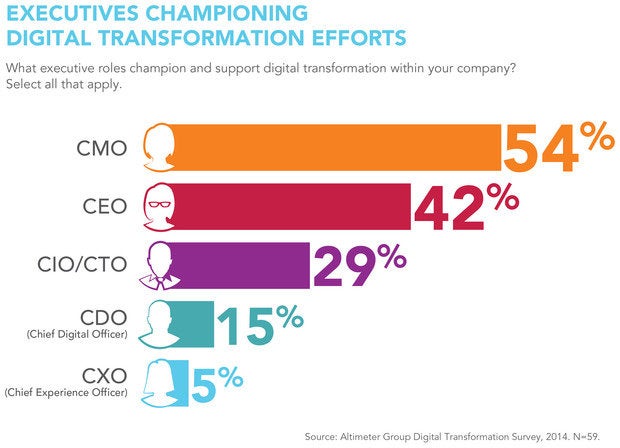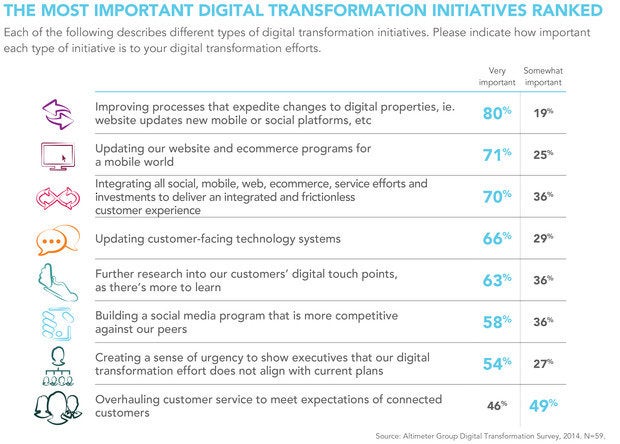by: Matt Kapko, CIO
Digital transformation is on the menu for most companies this year, but the ingredients needed are still being determined. However, new research highlights the recipes companies are using to evolve internal processes, structure and culture to match the evolution in customers’ behavior.
In today’s increasingly converged world, there’s a tendency to pit CIOs and CMOs against one another as if they’re standing in opposing corners of the ring. But that’s rarely the occasion, says Altimeter Group principal analyst Brian Solis, citing new research from the firm that focuses on the state of digital transformation among companies investing in the digital customer experience.
It’s a turf war that’s been sensationalized ad nauseam, and with few concrete examples. It turns out CIOs and CMOs are in much greater alignment than some would suggest.
“The CIO is more important than ever before,” says Solis. Instead of working against a technology roadmap, CIOs are now focusing on organizational processes and objectives that matter more to different types of customers and employees.

“That’s the irony about digital transformation, it doesn’t work when in of itself technology is the solution. Technology has to be an enabler and that enabler needs to be aligned with a bigger mission. We already found that companies that lead digital transformation from a more human center actually bring people together in the organization faster and with greater results,” Solis says.
Companies focused on the bigger picture are asking questions like how technology can enable them to achieve new things and what’s different about customers today versus yesterday. With the right information and foundation in place, technology becomes an enabler, not the answer, Solis adds.
Digital transformation in enterprise isn’t only about what the customers see and experience, according to the firm. Companies must evolve and reimagine their internal process, structure and culture to match this evolution in customer behavior among their employees. “It’s sort of transformation with purpose and once you have purpose you can have vision,” he says.
“Those companies that do start, especially from a digital customer experience perspective, they get answers that allow them to then see a path forward for how tech plays a role, but also how internally processes and people need to play a role that supports the greater goal,” says Solis. “No one person can do that alone.”
Indeed, Altimeter Group’s research found that digital transformation is most effective when somebody rises to the occasion. But among executives it’s the CMOs that are leading the charge at 54 percent, according to the firm. CEOs come next at 42 percent while CIOs and chief digital officers are championing and supporting digital transformation within their company by a rate of 29 percent, among 20 leading brands interviewed by Altimeter Group.
How to Compete for Digital Customers
The top challenge in digital transformation is culture, according to 63 percent of the companies surveyed, but cross-functional collaboration comes close behind. As businesses compete for digital customers, disparate groups must find a way to work together in a more collaborative manner, but it isn’t always easy or natural. More than half, 56 percent, of the companies surveyed by Altimeter Group said they find it difficult to work with the right people to create a consistent experience and journey that stitches together seamlessly.
“Part of the challenge is that, at the same time, external-facing teams are thinking about how the governance works and who owns what,” Ford’s former head of social media Scott Monty tells the firm. “In parallel, we have to figure out internally what infrastructure looks like, the people and the processes (HR), tools, and tech (IT). We have a need for an internal transformation with infrastructure going on at the same time that we’re trying to steer on the outside.”
One in Four Have Mapped the Digital Customer Journey
Most companies recognize the need to transform operations for digital employees and customers, but the path to reach that end is rarely paved. Almost 9 in 10, or 88 percent, of executives tell Altimeter that their company is undergoing a digital transformation effort in 2014, but only 25 percent have mapped out the digital customer journey.
Companies like Sephora are making this transformation by grouping every employee that touches a digital customer into a single team. Social media, customer service, sales, support and other functions are now equally equipped, informed and capable of meeting various customer needs.
“It all started with this greater intent to recognize that the digital customer is different than solving any one of these problems alone. To the customer we’re one brand, so we should act like it internally,” explains Solis.
“It’s not about egos, it’s not about politics, it’s not about point fingers. We just all recognize that in order to do this and to do this well and efficiently, we had to formally make people who didn’t work together now part of one team. So we start to see the forming of new teams within organization so that they can be more agile and more dynamic,” he says.
Finally, Altimeter Group asked the brands being surveyed to list the most important digital transformation initiatives underway within their organization. Here’s how they rank:



Leave a Reply